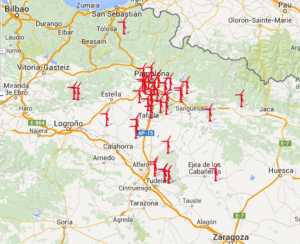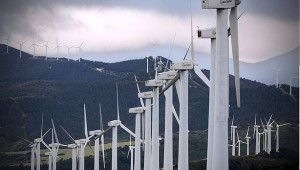Over the Easter break I had the opportunity to drive back and forth from Barcelona to San Sebastian (Donostia, in the basque language) and was deeply impressed by two striking features of the landscape.
The Lonely Mountain?

As you drive past Zaragoza heading northeast, the view is dominated by the Moncayo Massif, a series of peaks which rise to 2,315 meters and which are a protected national park. The mountains have glaciers, beach forests, and a number of different species of pine as well as other points of interest. Driving across northern Spain, the mountain appears as if by magic and is all alone, far from the Pyrenees and the Mountains of the Basque Country. It made me feel like Bilbo Baggins when he first sees Erebor from the distance. We did not, however, see the dragon.
Giants?
What we did see were windmills or what don Quijote de la Mancha mistook for giants. Not, of course, the old fashioned windmills that Cervantes wrote about but new modern windmills that cover the province of Navarra from end to end and have a capacity of over 1,000 MW of power.

To put that into perspective, wind generates about half of the electricity in the province and is part of the overall success story of Spain’s wind industry. Today Spain has an installed capacity of 23,000 MW and last year produced just over 20% of the country’s electrical energy or over 51,000 GWh. On the planet, Spain ranks fourth in wind energy behind China, the United States and Germany.
As a result of Spain’s fiscal problems and political situation, the present government has not only withdrawn support for the industry, which has been an example of Spain’s technological excellence, but has created an administrative vacuum in which additional investment is very difficult, to say the least. More information on the current state of the sector in Spain and on the government’s approach or lack thereof can be found in English in the annual report of the Spanish wind energy administration here.

While intellectually I have been following the evolution of the industry for some time, one only gets a sense of what is really possible by driving up the AP-15 and seeing row upon row of the giant machines pointing a way to a low carbon future. Perhaps if don Quijote were to see these machines slowly turning in the wind he would have thought he had run into an army of giants!
Not for everyone
While I personally find the machines majestic and inspiring, not everyone shares my enthusiasm for wind energy and there are many local groups who passionately oppose the technology. A typical example is the Australian organization called Stop These Things. The following is taken from the “About Us” button on their web site:
“We are a kitchen table group of citizens concerned about what is happening across rural and regional Australia, by the harm being done by the wind industry, in partnership with governments”
At the time of this writing, The National Wind Watch, a group which opposes wind energy, had identified over 120 groups like Stop These Things in the United States, 62 in Canada, 74 in the United Kingdom and dozens more around the world. Typically, opposition to wind energy is a very specific, local argument which essentially says that large utility-scale wind farms are unsightly and harmful to local inhabitants and wildlife.

In fact, James Lovelock, who first developed the Gaia hypothesis and is concerned to be the father of modern ecology, agrees and is a staunch opponent of wind energy, as he feels it ruins the landscape from a visual perspective. For him, despoiling the country in order to power wasteful cities makes little sense.
In Australia, Stop These Things takes these arguments further and insists that the science behind wind energy is fraudulent and the entire industry is just a scheme to transfer taxpayer money to wind energy developers who are, by its definition, corrupt.
While I have enormous respect for Dr. Lovelock and also understand the concerns of the local groups, I am convinced that wind energy will need to be part of our future if we are to take serious steps to lower our emissions of carbon dioxide.

